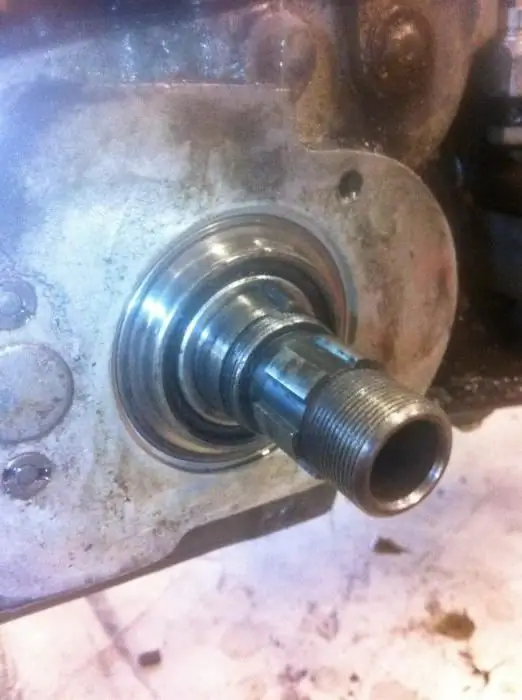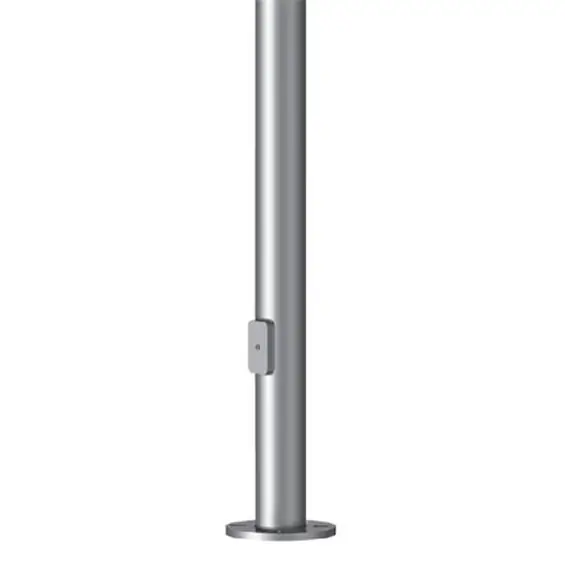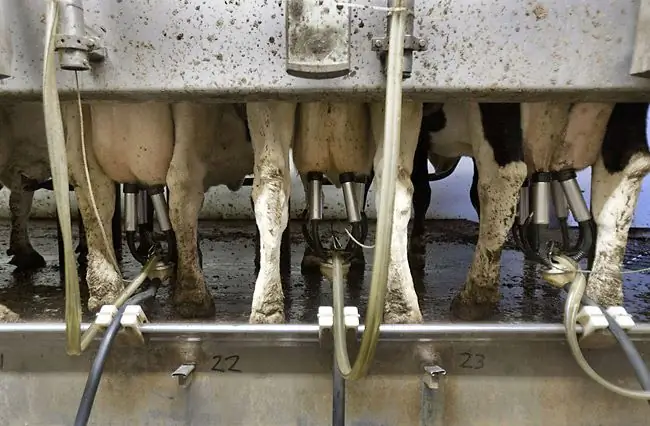2025 Author: Howard Calhoun | [email protected]. Last modified: 2025-01-24 13:10:41
Everyone is familiar with the concept of depreciation - it can be found in absolutely all spheres of life, in particular in mechanical engineering. Depreciation is a process that allows you to absorb, extinguish part of the impact exerted by one body or force on another body. This principle is used everywhere, from mitigating the impact of traffic on a car to taking into account the wear and tear of equipment in a plant.
However, in this article we will not talk specifically about depreciation, but about such a thing as a draft gear. If most people have heard of shock absorbers, then such devices may be new to many. The fact is that the draft gear is a highly specialized device that is most often used in trains. In this area, this mechanism is very important, it is installed in all cars, but it can differ in absorption types. This is what will be discussed in the article. What types of apparatus are there and for what purposes can they be used in different cases?
What is this?

First of all, you should understand what a draft gear is and what it serves for. So, this device is designed to repay or absorb (that's why it is called so) partimpact kinetic energy, thereby reducing the impact of various forces, including tensile and compressive forces, on the car frame where it is installed. How does an absorber work? Resistance arises inside the device, which ensures the transformation of kinetic force into other types of forces that do not harm the car. Therefore, the presence of such a device in the car is not a matter of choice, but a prerequisite, otherwise the acting forces can lead to serious damage to the train, which will entail sad consequences. As for the types of draft gear, there are a fairly large number of them, but not all of them are widespread. This article will describe in detail the main types and their action, as well as less popular types of devices.
No springs

Devices such as the RT-120 draft gear are now common, but it does not use springs, as it did in the beginning. The device has the following specifications:
- Apparatus type: friction.
- Maximum stroke: 120 millimeters.
- Maximum energy capacity: 90 kJ.
- Lifetime (before repair): 16 years.
- Total life: 32 years
Initially, such devices were exclusively spring-loaded, but over time they were replaced by useful and convenient, as well as much more functional and efficient devices. There were several problems, and the first of them was too much return of the springs. That is, they are goodabsorbed kinetic energy, but at the same time they gave it away almost as much, which leveled their usefulness. Secondly, in order for them to function competently in cars, it was necessary to form products that are quite large, one might say bulky, so they were abandoned. The low power consumption proved to be a decisive factor, because other devices could be made as efficient as spring-loaded ones, but much more compact. It is for this reason that devices such as the draft gear RT-120 are currently used in cars, and spring models are used exclusively in buffer devices.
Spring-friction devices

However, the fact that spring devices have not taken root in almost any area does not mean that such mechanisms have ceased to be used in this area. They just turned out to be not very effective, so spring-friction devices were created that transfer the main action to frictional movements, while the springs only have an additional function, that is, they are responsible exclusively for potential, and not kinetic energy. Let's see how it works. For example, the APE draft gear takes on the kinetic energy that is generated by the collision of two cars. First you need to indicate the technical characteristics of this device:
- Weight of the device: no more than 165 kilograms.
- Design stroke of the device: 90 millimeters.
- Nominal energy intensity: 110 kJ.
- Energy intensity maximum: 130 kJ.
- Initial tightening force: 230 kN.
- Static closing force: 1600 kN.
- Total life: 32 years
- Service life before repair: 16 years.
After the impact, the output is not the recoil energy of the springs, but the kinetic force of friction (that is, friction) and the potential energy of deformation of the springs. This result turned out to be more than satisfactory for the depreciation of wagons, so such devices are widely used.
Now you can find the 73ZW draft gear and other similar models everywhere. The product specifications are as follows:
- Weight of machine: 214 kg.
- Design stroke of the device: 90 mm.
- Operating temperature limit: +50°С to -60°С.
- Dimensions: length - 625 mm, width - 318 mm, height - 230 mm.
- Initial tightening force: 200 kN.
- Machine closing force: 1600 kN.
Advantages of spring-friction devices

Spring-friction devices began to be installed on cars a very long time ago and are still used today. Other types of devices exist, but this type is one of the most common. This happens for a number of reasons. First, it's simplicity. Secondly, the installation of draft gear of this type is a fairly simple and convenient process. Their dimensions are much smaller than those of spring devices, so the draft gears of freight cars are easy to install and do not cause difficulties infurther service. In addition, of course, it is necessary to note the variability and elementary design of these devices.
Hydraulic machines

Classes of draft gear are very diverse, and among them one more very popular type can be distinguished. Hydraulic devices differ significantly from spring-friction devices in their mode of action, since they are based on a liquid, which provides maximum shock absorption. The device has throttle openings calibrated accordingly. The strokes serve to ensure that shock-absorbing fluid flows through them. These holes connect two cavities, which, depending on the load, are filled through these through passages. As a result, a uniform elastic resistance is created, which works effectively even with fairly powerful blows.
Initially, there was one small problem, which consisted in the fact that the liquid could not quickly return to its original position, therefore, such an apparatus led to missed strokes, that is, to those moments when the liquid from one cavity did not have time to flow into another to soften the shaking of the wagon. That is why over time, in order to ensure the maximum elastic resistance in hydraulic devices, inert gas began to be used. Repair of this type of draft gear is slightly more complicated and expensive, but it is an efficient and convenient process to use. The device is considered defective if a leak is detectedfluid, change in stroke, or significant wear.
How is depreciation in hydraulic devices?

If we consider the hydraulic draft gear of the car, then here it is worth dwelling in more detail on the principle of operation of this device. How can water soften the blow? The answer to this question is given by physics, because the density and viscosity of water ensures the repayment and absorption of the kinetic energy of impact, which is lost in the process of passing through the liquid, at the moment it is overcome and pushed into the adjacent cavity through special holes. Thus, the draft gear of an automatic coupler, wagon, and any other element can be hydraulic, because it is also not too complicated. The use of an inert gas in this case is not mandatory. But thanks to this substance, the resistance of the liquid increases several times, and it also accelerates its return to its original state to take on the next blow.
Power consumption of the machine

If a draft gear is considered, then one of its most important parameters is energy intensity, and it is on it that you should pay attention in the first place. This parameter represents the amount of kinetic energy that the device is able to absorb before the full compression of its shock-absorbing elements, that is, until the moment when the device can no longer absorb the impact. Accordingly, the higher this indicator, the better. Springs haveextremely low energy intensity, which is why they are not used on large cars, where the impact force compresses the spring very quickly, which absorbs too little energy. It is also worth paying attention to the fact that the devices are created in such a way that the kinetic energy is not completely absorbed - there must be the right amount of energy that can return the device to its original position. This is why inert gas is used in hydraulic machines, because it requires not much kinetic energy to return the fluid to its original position.
Other types of devices
The types of draft gear described above are not the only ones - there are many more of them, but, as mentioned at the beginning of the article, only the most popular ones will be described here. So, it is worth noting the elastomeric draft gear, which is also very popular in various fields, including when installed in cars. This type almost exactly copies the described hydraulic devices, however, the main difference is that instead of ordinary water, which is throttled through calibrated holes, these devices use a special elastomeric fluid with a much higher viscosity, which increases its energy intensity, but at the same time makes it difficult service, and also increases the cost. Also, friction devices, which are considered devices from elastic elements, cannot be ignored. In them, the absorption of kinetic energy is carried out due to the deformation of the elements due to their friction. With a similar type, you alreadywe got to know each other superficially when we read about devices such as spring-friction devices.
Combined machines
It is worth mentioning separately combined devices, one example of which is almost the most common type - spring-friction. Simply put, combined devices include those that combine different types of depreciation. In this case, these are spring and friction types. The combinations can be varied. As indicated in the article, the combination of the action of springs and friction elements gave more than a positive result. It is this combined type of apparatus that is by far the most famous. In this field of activity, not all types of combinations of two types of draft gear are allowed. The simplest example is the combination of elastomeric and hydraulic devices, since they are similarly constructed and differ mainly only in the fluid used to maintain them.
Select machine
Which device should be chosen to achieve the goal? First of all, attention is drawn to the main parameter of draft gears - their energy intensity. It does not make sense to install a high energy device on wagons or other objects with low kinetic impact force, since high costs will be observed without increasing productivity. Also, in no case should devices with low energy intensity be placed on objects that are subjected to serious impacts, since the energy of the device simply will not be enough toabsorbing the right amount of energy, and the blows will be much stronger than allowed in accordance with established standards.
Of course, there are other parameters that you should pay attention to, such as stability, that is, the number of shocks successfully absorbed in relation to their total number, or the amount of irreversibly outgoing energy, which is completely absorbed by the absorbing device and is not used further to return it to its original position. These parameters are considered individually for each project, agreed upon before choosing a specific type of draft gear, in accordance with all established standards and requirements.
Recommended:
Connections: purpose, types of connections. Examples, advantages, disadvantages of types of compounds

Machines and machine tools, equipment and household appliances - all these mechanisms have many details in their design. Their high-quality connection is a guarantee of reliability and safety during work. What types of connections are there? Let's take a closer look at their characteristics, advantages and disadvantages
Order to reduce staff: sample drafting, draft and form. How to draw up an order to reduce the staff?

In a difficult financial situation, an enterprise is sometimes forced to carry out a special procedure, at the initial stage of which an order is drawn up to reduce staff. A sample of such a document must correspond to a certain form and take into account all the subtleties of labor legislation
Steel support: types, types, characteristics, purpose, installation rules, operation features and applications

Steel poles today are most often used as lighting poles. With their help, they equip the lighting of roads, streets, courtyards of residential buildings, etc. In addition, such structures are often used as supports for power lines
Equipment for agriculture: classification and types, purpose and application

Modern industry produces a variety of equipment for agriculture. It can be, for example, soil-cultivating equipment, as well as fodder, harvesting or sowing. Of course, tractors are also widely used on farms
Construction and stop valves: types and purpose

Today, a variety of types of building reinforcement are produced. It can be classified according to the method of manufacture or application, or according to the materials used in the production. Reinforcement, the thickness of which does not exceed 10 mm, is sold in coils. If its diameter in the profile is more than 10 mm, it is cut into bars 6–12 m long

